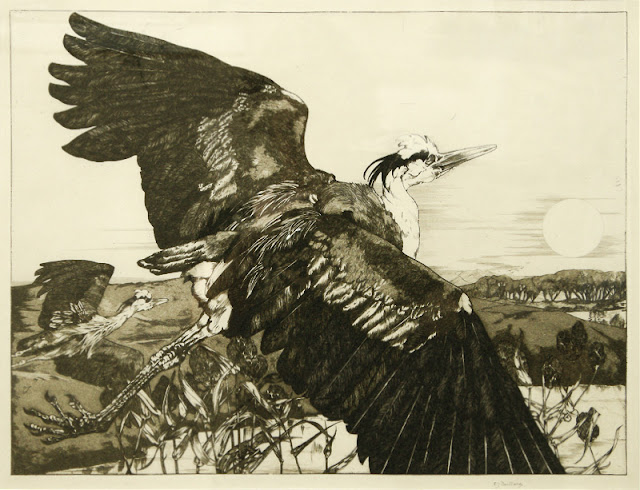This is part 1 of a 2-part post on the life and works of British illustrator Edward Julius Detmold (1883 – 1957). Edward and his twin brother Charles Maurice Detmold (1883 – 1908) were born in London in 1883. They were tutored by an uncle who fostered their artistic talents and their love of natural history. Their animal subjects were always among the most sensitive of their drawings. Prodigious early talents, they exhibited watercolours at the Royal Academy when they were 13 and had a portfolio of etchings issued in 1898.
The brothers worked jointly on their etchings and illustrations. Their first book illustrations were produced jointly for the 1899
Pictures From Birdland. Their next project, at the age of 20, was a portfolio of sixteen watercolours inspired by Rudyard Kipling's
The Jungle Book. They were well on their way to joint and individual success when Maurice suddenly committed suicide in 1908 – he was twenty-four years of age. No satisfactory explanation for the act has even been given. The coroner's inquest returned a verdict of suicide 'whilst unsound of mind' and there was apparently a note as well. Edward was stunned by the sudden death of his twin, but managed to continue on with his art.
His next book illustrations practically defined him to his publishers and their patrons. These were the 1909
The Fables of Aesop for which he did twenty-three colour plates and numerous pen and ink chapter headings. Then came Maurice Maeterlink's
The Life of the Bee and Birds and Beasts and
The Book of Baby Beasts in 1911. In 1912, it was the
Book of Baby Birds and
Hours of Gladness. Other books had titles like
The Book of Baby Pets and
The Book of Baby Dogs (1915),
Our Little Neighbours and
Fabre's Book of Insects (1921) - all reflecting the natural history that had so fascinated him as a youngster.
Even when he branched out, as he theoretically did in 1924 with his
The Arabian Nights, he was just as likely to choose animals to illustrate as he was to depict humans. It was to be his last illustrated work. In 1921 he had written a tract to attempt to explain himself, his work and his life. To quote from Keith Nicholson's introductory essay in
The Fantastic Creatures of Edward Julius Detmold:"A decade of intense activity was drawing to a close. Detmold could look back upon some fine achievements, but he was disillusioned with many of the uninspiring commissions for children's books he had undertaken. A pointless and destructive world war emphasized his worst forebodings of man's direction in the new century. The happiness of his childhood and the loss of his twin brother, now recollected in an uneasy tranquillity, combined to produce an existential crisis in the artist. In the wake of feeling that life for him had become meaningless and intolerable, he produced a literary work which testifies to his readings in Schopenhauerian pessimism and the Buddhist philosophy of the Upanishadr and the
Bhagavad-Gita. Life, his only un-illustrated work, a book of aphorisms, was published by J. M. Dent in 1921. A key book to an understanding of Detmold's mind,
Life is an inauspicious-looking small volume printed on one side of the leaf only. In his preface the author writes: `The following words have come to the writer, over a period of many years, as the fruits of self-overcoming.' From the curious, mystical text we learn that there are two ways of attainment: `The direct positive way - through progressive liberation - passing from the lesser realisation of the body, to the greater realisation of the mind, and therefrom to the realisation of the infinite through the soul; and the direct negative way -through disillusionment - which comes of infatuation with things in themselves, and the inevitable passing thereof.' In the event, Life was Detmold's farewell to the public world of books, and his testament."
Resigned from the world, Detmold went to live in Montgomeryshire where, after a long retirement and almost totally forgotten, he died in July, 1957. Strangely, there exists no official record of his death, though it is believed that he too committed suicide.
 |
| Amapolas from 'News of spring and other nature studies' 1917 |
 |
| At the Edge of the Lotus Pool etching & drypoint |
 |
| Birds in a Nest |
 |
| Catasetum y Cypripedium from 'News of spring and other nature studies' 1917 |
 |
| Cockerel etching |
 |
| Coryanthes Maculata from 'News of spring and other nature studies' 1917 |
 |
| Espinas from 'News of spring and other nature studies' 1917 |
 |
| From 'Birds and Beasts' 1911 |
 |
| From 'Birds of Town & Village' 1920 |
 |
| From 'Birds of Town & Village' 1920 |
 |
| From 'Birds of Town & Village' 1920 |
 |
| From 'Fabre's Book of Insects' 1921 |
 |
| From 'Fabre's Book of Insects' 1921 |
 |
| From 'Fabre's Book of Insects' 1921 |
 |
| From 'Fabre's Book of Insects' 1921 |
 |
| From 'Fabre's Book of Insects' 1921 |
 |
| From 'Hours of Gladness' |
 |
| From 'The Book of Baby Birds' 1912 |
 |
| From 'The Book of Baby Birds' 1912 |
 |
| From 'The Book of Baby Birds' 1912 |


































































